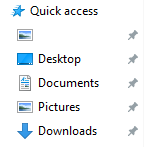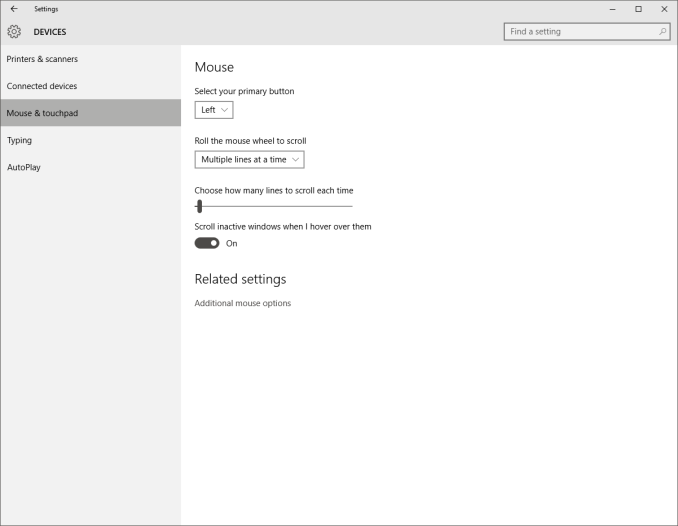The Windows 10 Review: The Old & New Face of Windows
by Brett Howse on August 25, 2015 8:00 AM EST- Posted in
- Operating Systems
- Microsoft
- Windows 10
More Desktop Changes
One of the goals of Windows 10 is to entice Windows 7 users to migrate to the new operating system. The additions we’ve seen already to the traditional mouse and keyboard interface have already been substantial, and should make most Windows 7 users comfortable. But they are not the only changes to the desktop. There is a little bit for everyone, both casual users and enthusiasts alike, so lets check out some more of the new features of Windows 10’s desktop.
Windows 8 changed up Windows Explorer, and brought in the ribbon menu. Office 2007 was the first Microsoft program to move from the file menu to the ribbon menu, and while it was controversial at the time, it is now very familiar. Moving Windows Explorer to a ribbon menu made it both easier to use with touch, as well as exposing settings and features that may have been tucked away in a submenu before. Windows 10 evolves this. Opening up Windows Explorer now greets you with a list of files you have recently accessed in the main pane. The thinking is that when you go to Explorer, you are likely looking for something you’ve used before. I won’t dispute the logic, but I prefer to see the computer view myself. Luckily it’s an easy option to change by clicking File->Change folder and search options. What I do like though is the Quick Access feature in Windows Explorer, which gives you – you guessed it – quick access to folders that are used a lot. The system will automatically add folders you go to frequently which is kind of great for discoverability, and you can add or remove any folder here. I have found it very useful, and since it is also built into the file picker for saving files, it makes it easy to get where I want to go when saving files.
Another nice feature to come to Windows Explorer is the Share contract. Windows 8 introduced contracts, which allow apps to communicate with one another over dedicated protocols, and adding it to Windows Explorer is a great way to expand them from the tablet style apps to the desktop. Share was likely the most useful contract, and I was always disappointed that the Windows 8 Charms did not offer any functionality on the desktop, so this is a great addition.
There are also small changes which improve Windows 10 over Windows 8. Things like having drop shadows back. Windows 8 went for a very flat UI, and it was clean looking but the lack of depth was not very useful with multiple windows open. Adding drop shadows back give the subtle definition around windows to make them stand out a bit more.
One of my favorite features that has come to Windows 10 is the ability to scroll an inactive window. Prior to Windows 10, and assuming you were not running a third party utility which enabled this, in order to scroll a window you had to first select it. Now, you can just move your mouse over any open window and use the scroll wheel to move whatever window you are over. You can do this on windows that are buried three or four deep – as long as you can see some of it you can scroll it. It is great when you are referencing a PDF or site, and writing at the same time, since you can continue to type while scrolling around in your reference document. For those that think this is insane, yes, you can turn it off.
Windows 8 seemed to signal that Microsoft was looking to a future past the desktop. There were some nice changes brought to the Windows 8 desktop but they were overshadowed by the changes brought in by the touch-first UI. With Windows 10, Microsoft is not only trying to bring back the focus on the desktop, they have added a lot of great features as well which should certainly entice users of both Windows 7 and 8.1 to want to switch.














293 Comments
View All Comments
lilmoe - Thursday, August 27, 2015 - link
Well if it works using Linux, then what's the problem?emilemil1 - Tuesday, August 25, 2015 - link
The "Share a OneDrive link" button isn't something new, it's been there on both Win7 and 8 for like a year now.http://arstechnica.com/information-technology/2014...
Brett Howse - Tuesday, August 25, 2015 - link
So I may be mistaken on the exact dates it came to 8.1, but it was in Windows 10 in the first release on October 1st. I don't recall seeing it added to 8.1 before that. Anyway regardless nice find I'll add a note in the review.piasabird - Tuesday, August 25, 2015 - link
A lot of these features in Windows 10 can simply be turned off. Some of them can be turned off during the initial boot up and install by selecting the advance settings and turning them off. I will admit that some of the settings seem to be hidden a bit or simply are in a different place. Some of the Internet settings that affect the browser cant be accessed inside of Edge?BMNify - Tuesday, August 25, 2015 - link
upgraded my windows 8.1 laptop to 10, looks like a good improvement and Cortana is awesome.bernstein - Tuesday, August 25, 2015 - link
The spyware aspect of this OS bothers me. I'll be using Windows 7 until this is reconsidered.Oxford Guy - Tuesday, August 25, 2015 - link
They're pushing out loads of "updates" that add the spyware in.sadsteve - Tuesday, August 25, 2015 - link
Well, all I can say is that the GUI, start menu, privacy and update issues have motivated me to seriously look at linux for my main machine for day to day activities. Most of the applications I currently use are open source or cross platform (Libre Office, jEdit, eclipse, Firefox, Thunderbird, etc) so making the switch shouldn't be too hard. Probably do dual boot so I have access to all my steam games and PhotoShop.wavetrex - Friday, August 28, 2015 - link
You're not alone brother...I've been a die-hard "windowser" since the days of Win 3.0, always saying "linux sux, it's behind, can never do the things windows does... etc."
Mint 17.2 'Rafaela' runs now on my 2nd SSD soooo smoothly. Moving more and more activities to it every day.
I guess that gaming will be the last one to "die" on winblowz.
Mr Perfect - Tuesday, August 25, 2015 - link
Does the stylus input only work with printed handwriting, or can it parse cursive? If it can digitize cursive, I could see it being very quick. The difference between on-screen keyboards and printing with individual letters would be close to a wash, though.